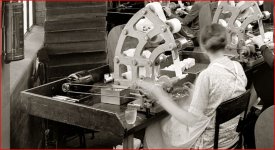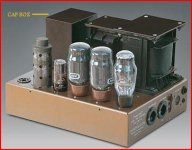Handling the films can be tricky. The separator material can be so thin, it seems to float on air, especially polypropylene (PP) and/or polyethylene (PE). It takes a lot of practice and patience to maneuver films by hand - and in small pieces. The length and amount of films to roll a capacitor is a different matter.
A film capacitor would need two lengths of metal foil (for the two electrodes). Cutting the foil can be tricky, because the edges have to be pristine (so edge burrs don't poke through the separator), so you'd want the metal professionally pre-cut to your specifications. Then you need sandwich and roll the separator between the two electrode foils. The electrodes are offset, so the edge of one foil overextends the seperator on one side, and the other foil overextends the other side. Then the terminals are welded on to the overextended foils on each side. Welds have to be done carefully, as to not damage the separator at the edges.
To make one by hand, here's what you need:
1. a spool of separator (could be paper for PIO) cut to the desired width.
2. two spools of electrode foil cut to the desired width.
3. a precision winding machine or jig capable of three or four layer windings (two metal foils and one or two layers of separator).
4. electrolyte or oil.
5. vacuum chamber for evacuating air and drawing in the electrolyte or oil.
6. apparatus to dispense the electrolyte or oil into the vacuum-drawn cell body.
7. end terminals cut to the correct shape of the cell body windings.
8. welder to attach end terminals.
9. case, can, enclosure, or external wrapper.
10. end sealant.
I have much experience building electrochemical energy storage using foil & separators (including polypropylene, polyethylene, silica, and more). It's certainly not impossible to do at home, but would be expensive to setup and obtain cut foils, separators, electrolytes, oils, etc. It would also be an excellent learning opportunity.
Google it. I'm sure some guy has made capacitors using kitchen-grade aluminum foil, old newspapers, and vegetable oil ... although keep a fire extinguisher handy and don't leave the amplifier unattended because of the near-certitude of a fire.
EDIT: Here's a youtube video of what appears to be a paper-and-foil wrap fastened together with some zip ties. Some of the comments suggest soaking it in mineral oil. Here's a discussion thread on building a capacitor and discussing the use of a vacuum pump. The capacitor is apparently for high voltage Tesla experiments. I'm sure there's tons of resources.
A film capacitor would need two lengths of metal foil (for the two electrodes). Cutting the foil can be tricky, because the edges have to be pristine (so edge burrs don't poke through the separator), so you'd want the metal professionally pre-cut to your specifications. Then you need sandwich and roll the separator between the two electrode foils. The electrodes are offset, so the edge of one foil overextends the seperator on one side, and the other foil overextends the other side. Then the terminals are welded on to the overextended foils on each side. Welds have to be done carefully, as to not damage the separator at the edges.
To make one by hand, here's what you need:
1. a spool of separator (could be paper for PIO) cut to the desired width.
2. two spools of electrode foil cut to the desired width.
3. a precision winding machine or jig capable of three or four layer windings (two metal foils and one or two layers of separator).
4. electrolyte or oil.
5. vacuum chamber for evacuating air and drawing in the electrolyte or oil.
6. apparatus to dispense the electrolyte or oil into the vacuum-drawn cell body.
7. end terminals cut to the correct shape of the cell body windings.
8. welder to attach end terminals.
9. case, can, enclosure, or external wrapper.
10. end sealant.
I have much experience building electrochemical energy storage using foil & separators (including polypropylene, polyethylene, silica, and more). It's certainly not impossible to do at home, but would be expensive to setup and obtain cut foils, separators, electrolytes, oils, etc. It would also be an excellent learning opportunity.
Google it. I'm sure some guy has made capacitors using kitchen-grade aluminum foil, old newspapers, and vegetable oil ... although keep a fire extinguisher handy and don't leave the amplifier unattended because of the near-certitude of a fire.
EDIT: Here's a youtube video of what appears to be a paper-and-foil wrap fastened together with some zip ties. Some of the comments suggest soaking it in mineral oil. Here's a discussion thread on building a capacitor and discussing the use of a vacuum pump. The capacitor is apparently for high voltage Tesla experiments. I'm sure there's tons of resources.
Last edited:
Google it. I'm sure some guy has made capacitors using kitchen-grade aluminum foil, old newspapers, and vegetable oil ...
I was under the impression home-made capacitors were common in the early days of home electronics, most often wax types. Not that I see any reason other than challenge these days.
I was under the impression home-made capacitors were common in the early days of home electronics, most often wax types. Not that I see any reason other than challenge these days.
Or special purpose - say very high voltage capacitors for a "Tesla coil" or other HV experiments can be awfully difficult and expensive to come by yet they can be easily made out of common household items.
Those interested can find many ideas on the subject online, from making of capacitors ot making them look better ("modding"), which can be applied directly to produce "professional-looking" parts. I can't find the "modding" webpage right now, I do recall author using wooden cylinders and beeswax to repack industrial capacitors though.
I was under the impression home-made capacitors were common in the early days of home electronics, most often wax types. Not that I see any reason other than challenge these days.
Back in high school physics, we made capacitors using tin foil and toothpaste as an electrolyte.
I don't think we ever tested them however, and I'm not even sure if they would work at all... But if they did, some Colgate caps would be interesting to try out...

Nice picture, pointy!
You can clearly see she has the former prepared with a few wraps of separator material, but hasn't started the metal foil electrodes yet. The top metal foil spool has a bit hanging, which I suppose she is starting. Notice her neighbor is actively wrapping all parts ... you can see the top and bottom metal foils sandwiching several layers of separator.
Notice the winding machines have several spools of separator. It appears three spools are active, so this particular capacitor has three layers of separator between the two foil electrodes.
You can clearly see she has the former prepared with a few wraps of separator material, but hasn't started the metal foil electrodes yet. The top metal foil spool has a bit hanging, which I suppose she is starting. Notice her neighbor is actively wrapping all parts ... you can see the top and bottom metal foils sandwiching several layers of separator.
Notice the winding machines have several spools of separator. It appears three spools are active, so this particular capacitor has three layers of separator between the two foil electrodes.
yes you would need 2 layers plus of paper, they worked for “atwater kent radios” and in the full picture there maybe about 50 people making caps. in the picture you can see some wooden trays the workers would fill them with outer cans and then pop in the inserts(they were paid by the tray). after that some guy would come round dressed in a brown lab coat and put the trays on a rack shelf and then oil them. some company used a vibration shelf to cut down the time it would take to shack the air bubbles out.
if you are making more than one cap for an amp you can try to do it as "leak" did. put them all in a metal box with a full flange and gasket so the top seals on, nearly all of these have lasted 50 years with no "leaks".
if you are making more than one cap for an amp you can try to do it as "leak" did. put them all in a metal box with a full flange and gasket so the top seals on, nearly all of these have lasted 50 years with no "leaks".
I have four (4) 0.22/630V Jensen silver PIO caps. They retail at $204 each.
For that price they better have a 10,000 year on-site warranty replacement. Have you tried contacting the manufacturer about replacements?
For that price they better have a 10,000 year on-site warranty replacement. Have you tried contacting the manufacturer about replacements?
Frankly ,I never thought about it. They must be 10 years old and it didn't cross my mind that any manufacturer would honor warranty for such a long period. I remember Peter Q. saying that silver is highly reactive and if one wants the best, than must be ready for inevitable. That must have been a dark period in my life
Frankly ,I never thought about it. They must be 10 years old and it didn't cross my mind that any manufacturer would honor warranty for such a long period. I remember Peter Q. saying that silver is highly reactive and if one wants the best, than must be ready for inevitable. That must have been a dark period in my life.I'll try to email Jensen next week, maybe they have generous trade-in policy ??
................
I guess I should dump the silver-plated connectors for pure copper then?
[/sarcasm]
Last edited:
I made a capacitor when I was a kid.. Aluminum foil sheets, and wax paper sheets. Coiled it up as tight as I could. Stuck it in a golf club holder/tube thing. Put a doorknob on the end, went around the house collecting as much static electricity as I could, and made a little spark.
that was the last I thought about that until a few days ago when I took apart a russian tefflon.. It's just 2 layers of foil a a few layers a tefflon coiled up.
Now I'm curious of the audio properties of my aluminum foil/wax paper cap.. haha..
that was the last I thought about that until a few days ago when I took apart a russian tefflon.. It's just 2 layers of foil a a few layers a tefflon coiled up.
Now I'm curious of the audio properties of my aluminum foil/wax paper cap.. haha..
- Status
- This old topic is closed. If you want to reopen this topic, contact a moderator using the "Report Post" button.
- Home
- Design & Build
- Parts
- Oil filled caps - how are they made? DIY caps?

